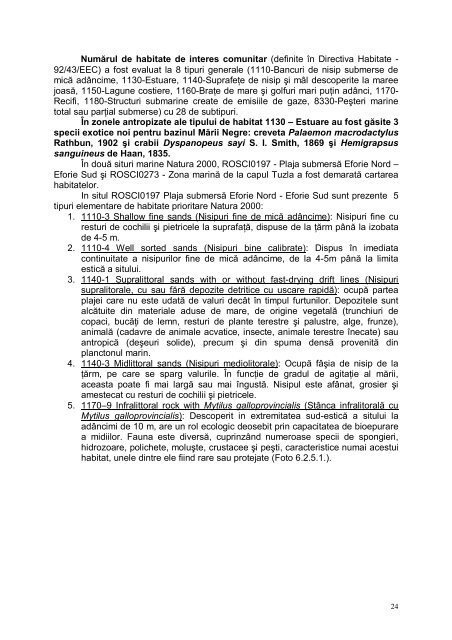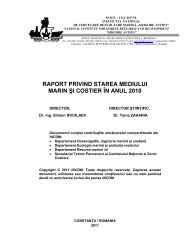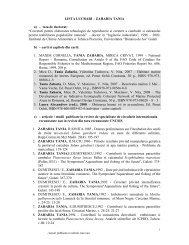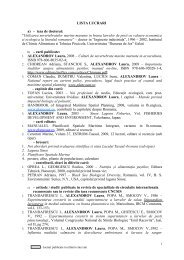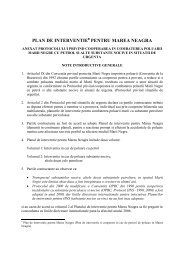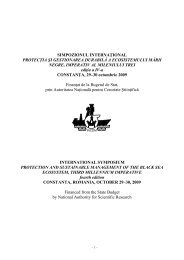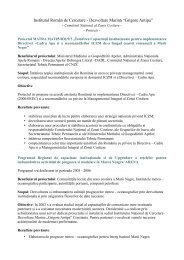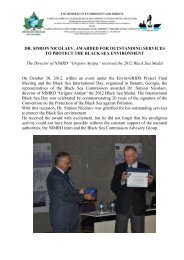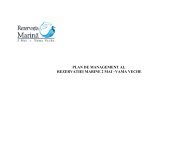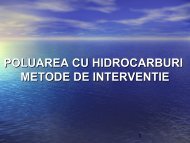Raport de stare al mediului pe anul 2009 - Institutul Naţional de ...
Raport de stare al mediului pe anul 2009 - Institutul Naţional de ...
Raport de stare al mediului pe anul 2009 - Institutul Naţional de ...
Create successful ePaper yourself
Turn your PDF publications into a flip-book with our unique Google optimized e-Paper software.
Numărul <strong>de</strong> habitate <strong>de</strong> interes comunitar (<strong>de</strong>finite în Directiva Habitate -<br />
92/43/EEC) a fost ev<strong>al</strong>uat la 8 tipuri gener<strong>al</strong>e (1110-Bancuri <strong>de</strong> nisip submerse <strong>de</strong><br />
mică adâncime, 1130-Estuare, 1140-SuprafeŃe <strong>de</strong> nisip şi mâl <strong>de</strong>sco<strong>pe</strong>rite la maree<br />
joasă, 1150-Lagune costiere, 1160-BraŃe <strong>de</strong> mare şi golfuri mari puŃin adânci, 1170-<br />
Recifi, 1180-Structuri submarine create <strong>de</strong> emisiile <strong>de</strong> gaze, 8330-Peşteri marine<br />
tot<strong>al</strong> sau parŃi<strong>al</strong> submerse) cu 28 <strong>de</strong> subtipuri.<br />
În zonele antropizate <strong>al</strong>e tipului <strong>de</strong> habitat 1130 – Estuare au fost găsite 3<br />
s<strong>pe</strong>cii exotice noi <strong>pe</strong>ntru bazinul Mării Negre: creveta P<strong>al</strong>aemon macrodactylus<br />
Rathbun, 1902 şi crabii Dyspano<strong>pe</strong>us sayi S. I. Smith, 1869 şi Hemigrapsus<br />
sanguineus <strong>de</strong> Haan, 1835.<br />
În două situri marine Natura 2000, ROSCI0197 - Plaja submersă Eforie Nord –<br />
Eforie Sud şi ROSCI0273 - Zona marină <strong>de</strong> la capul Tuzla a fost <strong>de</strong>marată cartarea<br />
habitatelor.<br />
In situl ROSCI0197 Plaja submersă Eforie Nord - Eforie Sud sunt prezente 5<br />
tipuri elementare <strong>de</strong> habitate prioritare Natura 2000:<br />
1. 1110-3 Sh<strong>al</strong>low fine sands (Nisipuri fine <strong>de</strong> mică adâncime): Nisipuri fine cu<br />
resturi <strong>de</strong> cochilii şi pietricele la suprafaŃă, dispuse <strong>de</strong> la Ńărm până la izobata<br />
<strong>de</strong> 4-5 m.<br />
2. 1110-4 Well sorted sands (Nisipuri bine c<strong>al</strong>ibrate): Dispus în imediata<br />
continuitate a nisipurilor fine <strong>de</strong> mică adâncime, <strong>de</strong> la 4-5m până la limita<br />
estică a sitului.<br />
3. 1140-1 Supr<strong>al</strong>ittor<strong>al</strong> sands with or without fast-drying drift lines (Nisipuri<br />
supr<strong>al</strong>itor<strong>al</strong>e, cu sau fără <strong>de</strong>pozite <strong>de</strong>tritice cu uscare rapidă): ocupă partea<br />
plajei care nu este udată <strong>de</strong> v<strong>al</strong>uri <strong>de</strong>cât în timpul furtunilor. Depozitele sunt<br />
<strong>al</strong>cătuite din materi<strong>al</strong>e aduse <strong>de</strong> mare, <strong>de</strong> origine veget<strong>al</strong>ă (trunchiuri <strong>de</strong><br />
copaci, bucăŃi <strong>de</strong> lemn, resturi <strong>de</strong> plante terestre şi p<strong>al</strong>ustre, <strong>al</strong>ge, frunze),<br />
anim<strong>al</strong>ă (cadavre <strong>de</strong> anim<strong>al</strong>e acvatice, insecte, anim<strong>al</strong>e terestre înecate) sau<br />
antropică (<strong>de</strong>şeuri soli<strong>de</strong>), precum şi din spuma <strong>de</strong>nsă provenită din<br />
planctonul marin.<br />
4. 1140-3 Midlittor<strong>al</strong> sands (Nisipuri mediolitor<strong>al</strong>e): Ocupă fâşia <strong>de</strong> nisip <strong>de</strong> la<br />
Ńărm, <strong>pe</strong> care se sparg v<strong>al</strong>urile. În funcŃie <strong>de</strong> gradul <strong>de</strong> agitaŃie <strong>al</strong> mării,<br />
aceasta poate fi mai largă sau mai îngustă. Nisipul este afânat, grosier şi<br />
amestecat cu resturi <strong>de</strong> cochilii şi pietricele.<br />
5. 1170–9 Infr<strong>al</strong>ittor<strong>al</strong> rock with Mytilus g<strong>al</strong>loprovinci<strong>al</strong>is (Stânca infr<strong>al</strong>itor<strong>al</strong>ă cu<br />
Mytilus g<strong>al</strong>loprovinci<strong>al</strong>is): Desco<strong>pe</strong>rit in extremitatea sud-estică a sitului la<br />
adâncimi <strong>de</strong> 10 m, are un rol ecologic <strong>de</strong>osebit prin capacitatea <strong>de</strong> bioepurare<br />
a midiilor. Fauna este diversă, cuprinzând numeroase s<strong>pe</strong>cii <strong>de</strong> spongieri,<br />
hidrozoare, polichete, moluşte, crustacee şi <strong>pe</strong>şti, caracteristice numai acestui<br />
habitat, unele dintre ele fiind rare sau protejate (Foto 6.2.5.1.).<br />
24


